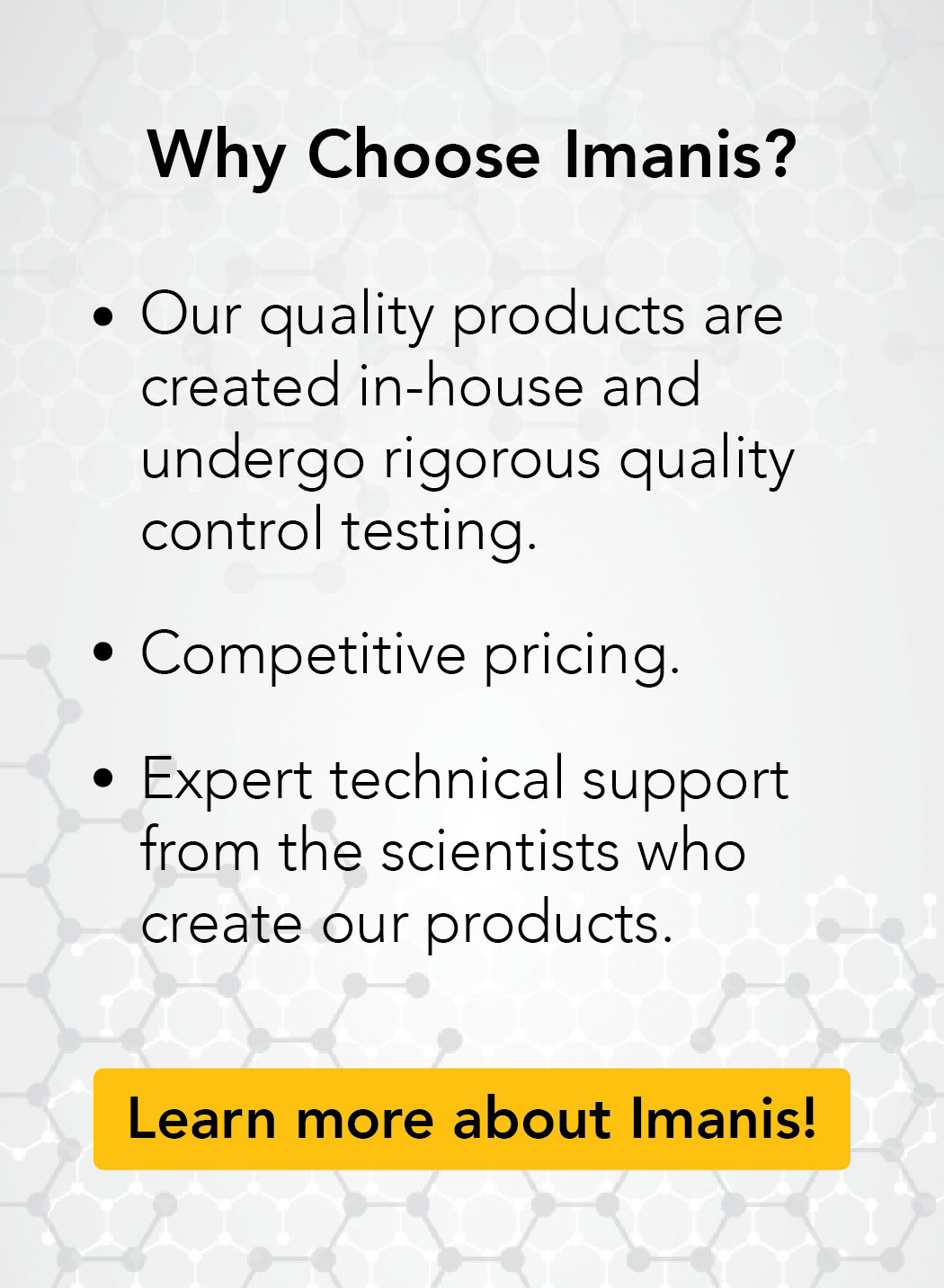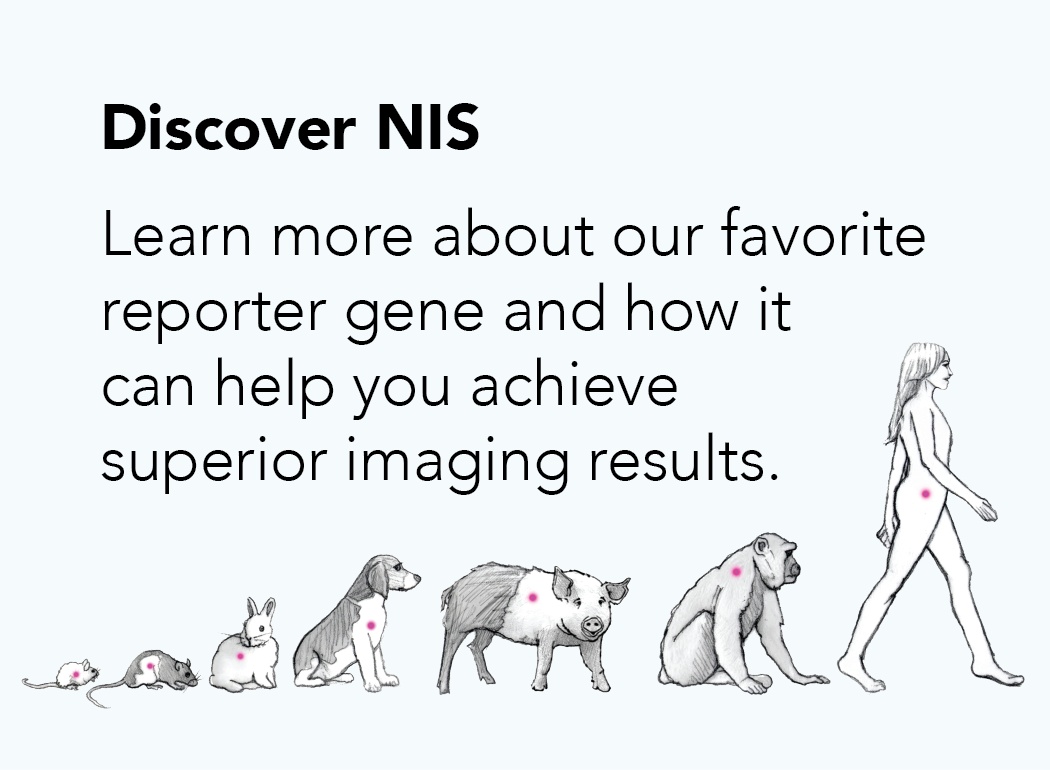What is the source of the transgenes?
Our transgenes come from a variety of sources. Check out the table below for detailed information about the source of our transgenes.
| Transgene | Accession # | Gene Source | Description |
|---|---|---|---|
| Luc2 | AY738222 | Photinus pyralis | Codon optimized firefly luciferase with brighter signal1. |
| hNIS | U66088 | Homo sapiens | Human sodium iodide symporter; mediates iodide uptake2. |
| hNISplus | Mutant of
U66088 |
Homo sapiens | Genetically modified hNIS with enhanced radiotracer uptake. |
| mNIS | AF235001 | Mus musculus | Murine (mouse) sodium iodide symporter; mediates iodide uptake3. |
| rNIS | U60282.1 | Rattus norvegicus | Rat sodium iodide symporter; mediates iodide uptake4. |
| pigNIS | NM214410 | Sus scrofa | Pig sodium iodide symporter; mediates iodide uptake5. |
| RhNIS | N/A* | Rhesus macaque | Rhesus sodium iodide symporter; mediates iodide uptake. |
| dNIS | XM_541946 | Canis lupus | Dog sodium iodide symporter; mediates iodide uptake6. |
| IRES | M81861
(nt 260 to 848) |
EMCV | Internal ribosome entry site; RNA element that mediates internal translation initiation7. |
| eGFP | AAB02572.1 | Variant of GFP from Aequorea victoria | Enhanced GFP; mutant of GFP with a 100-fold increase in fluorescent signal8. |
| iRFP | JN247409 | Rhodopseudomonas palustris | Near-infrared fluorescent protein; red-shifted fluorescent protein with an excitation/emission of 690/713 nm9. |
| dsRed | AB212907 | Anopheles gambiae | Red fluorescent protein variant with an excitation/emission of 558/583 nm10. |
| DRD2 | NM_016574.3 | Homo Sapiens | Dopamine receptor D2; endogenously expressed in the brain11. |
| hNET | NM_001172501.1 | Homo Sapiens | Human norepinephrine transporter; endogenously expressed by noradrenergic neurons12. |
| SSTR2 | AY236542.1 | Homo Sapiens | Somatostatin receptor 2; endogenously expressed in cerebrum and kidneys13. |
| HSV-TK | JQ352282.1 | HSV | Human herpesvirus 1 thymidine kinase (UL23)14. |
| hTYR | M27160.1 | Homo sapiens | Tyrosinase; converts tyrosine to brown-pigmented melanin15. |
*Sequence derived from a cDNA library. Email support@imanislife.com for more information.
1 Promega
2 Smanik et al. Biochem Biophys Res Commun. 1996. 226(2):339-45
3 Pinke et al. Thyroid. 2001. 11(10):935-9
4 Dai et al. Nature. 1996. 379(6564):458-60
5 Selmi-Ruby et al. Endocrinology. 2003. 144(3):1074-85
6 Uyttersprot et al. Mol Cell Endocrinol. 1997. 131(2):195-203
7 Gurtu et al. Biochem Biophys Res Commun. 1996. 229(1):295-8
8 Cormack et al. Gene. 1996. 173(1):33-8
9 Filonov et al. Nat Biotechnol. 2011. 29(8):757-61
10 Baird et al. Proc Natl Acad Sci USA. 2000. 97(22):11984-9
11 Dearry et al. Cell Mol Neurobiol. 1991. 11(5):437-53
12 Pacholczyk et al. Nature. 1991. 350(6316):350-4
13 Parry et al. Mol Imaging. 2007. 6(1):56-67
14 Koehne et al. Nat Biotechnol. 2003. 21(4):405-13
15 Takeda et al. Biochem Biophys Res Commun. 1989. 162(3):984-90

